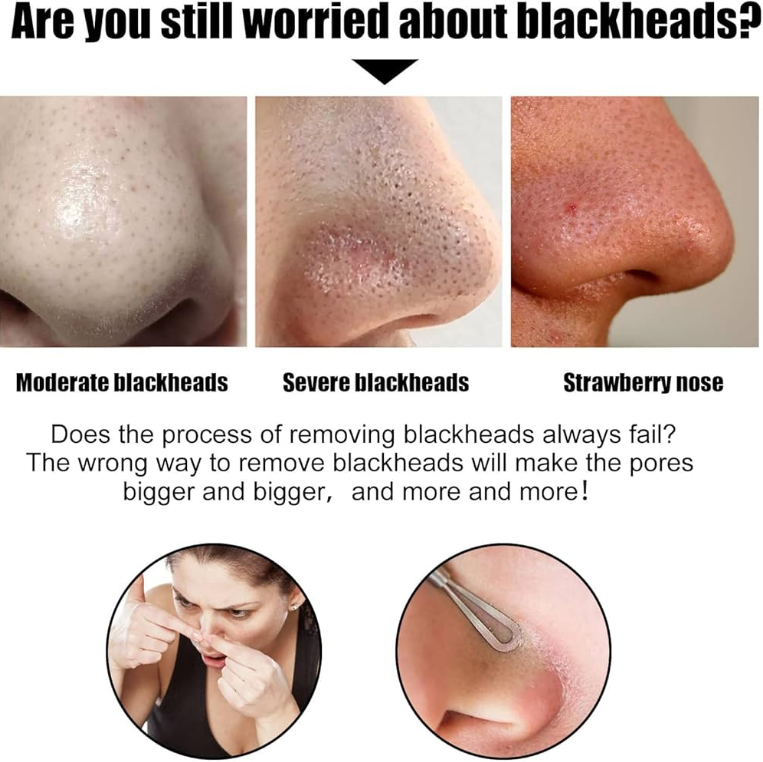BOURSESSENEGAL – Blackheads on the nose can be frustrating and unsightly. These small, dark spots form when hair follicles become clogged with excess oil and dead skin cells. While they’re a common skin concern, understanding their causes and effective treatments can help you achieve clearer skin. In this comprehensive guide, we will delve into the factors that contribute to blackheads, explore various treatment options, and share preventive measures to keep your skin looking its best.
What Are Blackheads?
Definition and Characteristics
Blackheads are a type of acne known as open comedones. They occur when a hair follicle becomes clogged with sebum (oil) and dead skin cells. Unlike whiteheads, which are closed and appear as small white bumps, blackheads remain open to the air. This exposure causes the material inside to oxidize and turn black, giving them their distinct appearance.
Common Areas for Blackheads
While blackheads can form anywhere on the body, they are most commonly found on the nose. This area tends to have more sebaceous (oil) glands, making it more prone to clogged pores. Other areas where blackheads often appear include the forehead, chin, and back.
Causes of Blackheads on the Nose
1. Excess Oil Production
One of the primary causes of blackheads is excess oil production. Factors such as hormonal changes, diet, and genetics can lead to increased sebum production. When oil mixes with dead skin cells, it can clog pores and form blackheads.
2. Dead Skin Cell Buildup
The skin constantly sheds dead cells. If these cells do not slough off properly, they can accumulate in hair follicles, contributing to blackhead formation. Exfoliating regularly can help prevent this buildup.
3. Poor Skincare Habits
Using heavy or comedogenic skincare products can exacerbate blackheads. Products that contain oils or certain silicones may clog pores, leading to more blackheads. Choosing non-comedogenic products is crucial for maintaining clear skin.
4. Environmental Factors
Pollution, humidity, and exposure to certain chemicals can also play a role in blackhead formation. Environmental pollutants can clog pores, and humidity can increase oil production. Keeping your skin clean can help minimize these effects.
Effective Treatments for Blackheads on the Nose
1. Cleansing and Exfoliating
A consistent skincare routine is vital for managing blackheads. Start with a gentle cleanser that removes excess oil and impurities without over-drying the skin. Follow this with regular exfoliation to help slough off dead skin cells.
Recommended Exfoliants
- Chemical Exfoliants: Products containing salicylic acid or glycolic acid are particularly effective for treating blackheads. Salicylic acid penetrates the pores and helps dissolve the debris causing blockages.
- Physical Exfoliants: While they can be beneficial, use them sparingly. Choose gentle scrubs to avoid irritating the skin.
2. Pore Strips
Pore strips can be a quick solution for removing blackheads. These adhesive strips pull out dirt and oil from your pores, leaving your skin feeling smoother. However, they provide only temporary relief and should not replace a comprehensive skincare routine.
3. Clay Masks
Clay masks can help absorb excess oil and draw out impurities from the skin. Look for masks containing bentonite or kaolin clay, as these ingredients are known for their oil-absorbing properties. Using a clay mask once or twice a week can help reduce blackheads.
4. Retinoids
Topical retinoids, derived from vitamin A, can effectively treat blackheads by promoting cell turnover and preventing clogged pores. Over-the-counter options like adapalene are available, but consult a dermatologist for prescription-strength alternatives.
5. Professional Treatments
If blackheads persist, consider seeking professional treatments. Dermatologists offer various options, including:
- Extraction: A dermatologist can safely extract blackheads using specialized tools, minimizing the risk of scarring or infection.
- Chemical Peels: These treatments use stronger acids to exfoliate the skin and reduce blackheads over time.
- Microdermabrasion: This technique exfoliates the outer layer of skin, helping to improve texture and reduce the appearance of blackheads.
Preventing Blackheads on the Nose
1. Maintain a Consistent Skincare Routine
Establishing a regular skincare routine can help prevent blackheads from forming. Cleanse your skin daily and exfoliate regularly to remove dead skin cells.
2. Choose Non-Comedogenic Products
When selecting skincare and makeup products, opt for non-comedogenic options. These products are specifically formulated to avoid clogging pores, reducing the likelihood of blackheads.
3. Keep Your Skin Hydrated
Hydrated skin produces less oil, which can help minimize blackhead formation. Use a lightweight, oil-free moisturizer to keep your skin balanced.
4. Avoid Touching Your Face
Your hands come into contact with various surfaces that can transfer dirt and oil to your face. Avoid touching your face to minimize the risk of clogging your pores.
5. Regularly Change Pillowcases and Towels
Bacteria and oil can accumulate on pillowcases and towels, contributing to blackhead formation. Change these regularly to keep your skin clean and fresh.
Conclusion: Achieving Clear Skin
Blackheads on the nose can be a persistent issue, but understanding their causes and exploring effective treatments can help you regain clear, smooth skin. By maintaining a consistent skincare routine, using suitable products, and considering professional options, you can minimize blackheads and enhance your overall complexion.
Start implementing these strategies today, and embrace the journey to clearer skin. Remember, achieving and maintaining healthy skin is a process, so be patient and stay committed to your skincare regimen!
This guide provides valuable insights into blackheads while engaging the reader effectively. If you have specific requests or need further adjustments, just let me know
REFERENCE : https://www.health.com/



